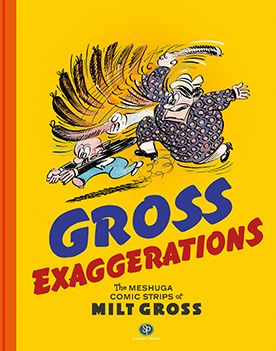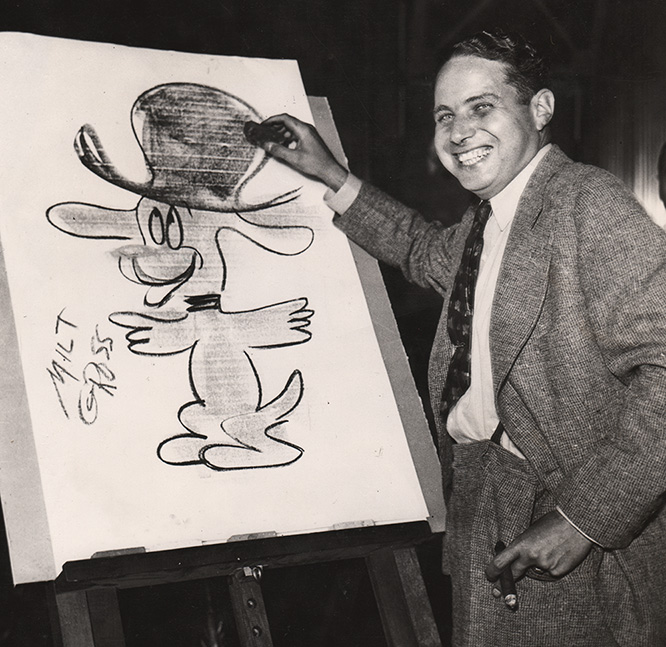
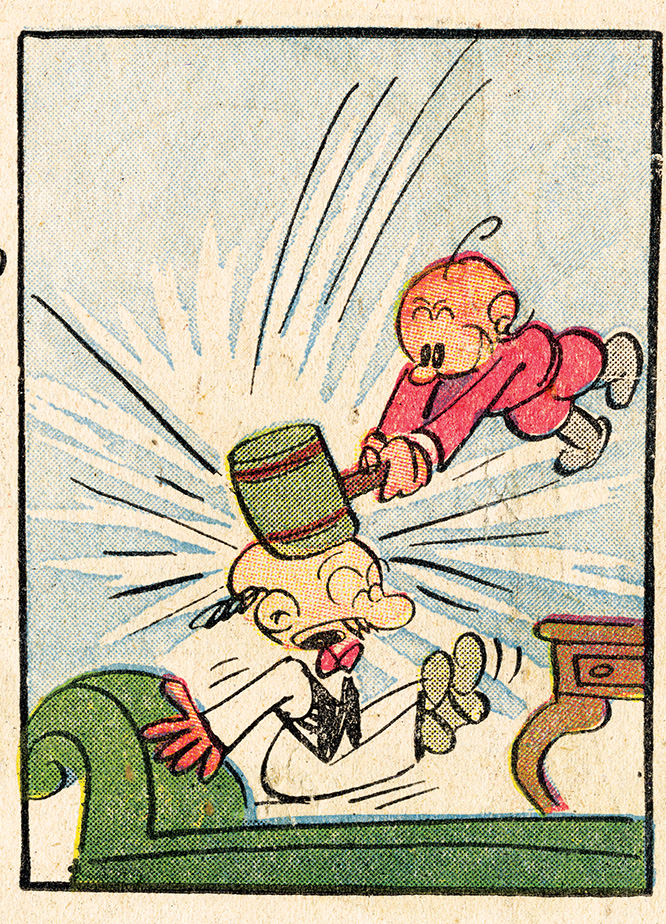
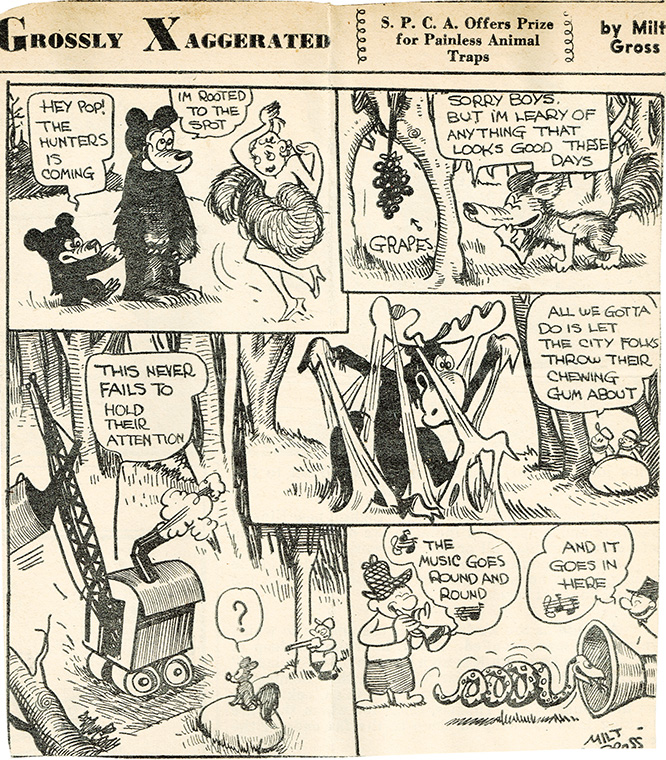
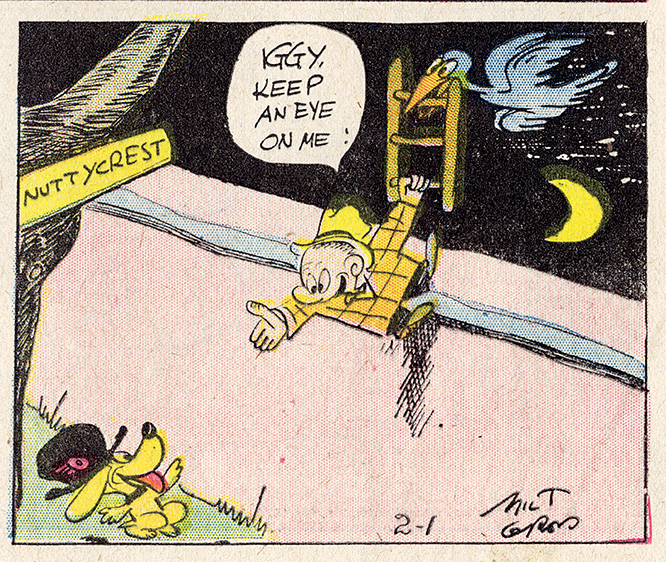
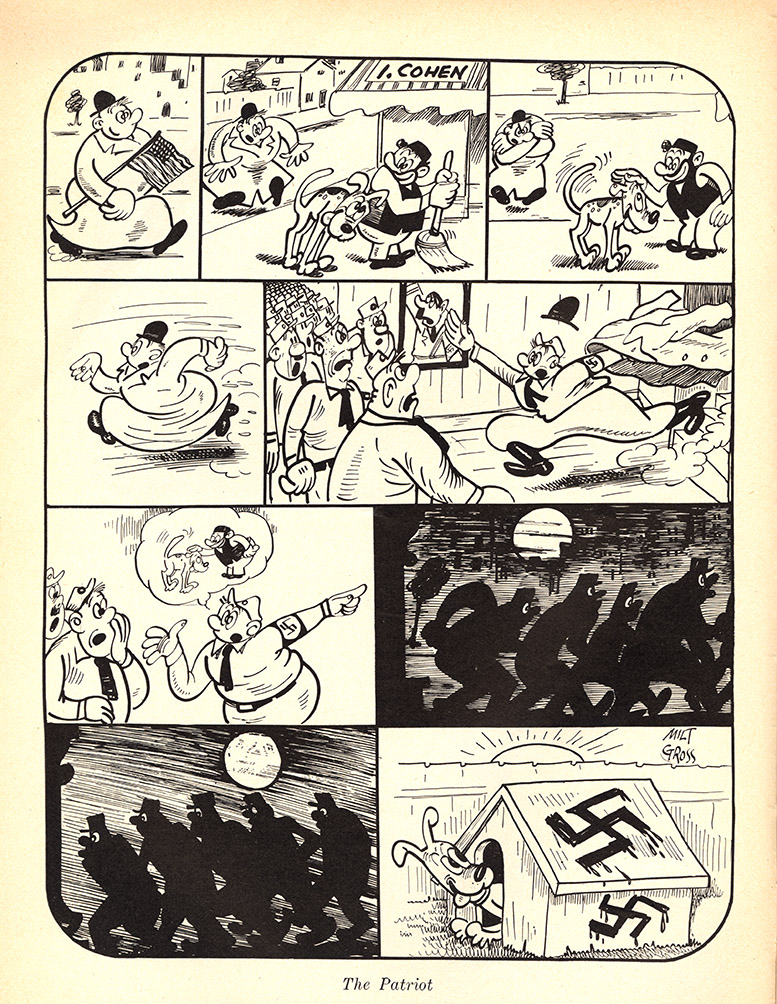
From the Foreword by Ivan Brunetti
Genius can manifest itself in two ways: the unfathomably complex, and the unfathomably simple. Milt Gross belongs to the latter category. He is one of the all-time great cartoonists because he makes the craft integral to the entire endeavor look so easy, even enjoyable. When I envision the word “cartooning” in the dictionary, the accompanying illustration is always a drawing by Gross: Nize Baby, Iggy, Count Screwloose, or any number of walk-on characters from his strips. These spirited drawings embody cartooning both as noun and verb. Gross is an elemental force, and his command of line and form convincingly argues for cartooning as the purest, the most natural, instinctive, and expressive—it’s tempting to say the only—way to draw.
Milt Gross must have been an attentive listener, judging by his exquisite ear for dialect, slang, turns of phrase, back-and-forth rhythms, the lyricism of the everyday. Life’s incongruities are a continual source of inspiration; true bedlam lies outside the asylum, and dreams are no more surreal than the “real” world. The gags are inventive in setup and payoff: the more complicated the conundrum, the nuttier the solution. The human tendency toward hypocrisy is punctured when least unexpected and by unlikely sources, but there is never a sense of contempt or scorn, only a deep empathy for our follies and foibles, an acceptance of absurdity as part and parcel of existence.
From the introduction by Mark Newgarden
Gross was first and foremost a product of American popular culture and operated with the understanding that his latest gag had already begun disintegration on contact with oxygen (as all popular culture must). And while his generation’s bag of tricks has been long absorbed into the hardpacked humus of cartooning convention, this restless artist’s best work remains a revelation, compulsively energetic and still uncompromisingly funny. His mature line work in particular maintains a markedly fresh vigor and offhanded edginess that offers up as much a whiff of the avant-garde as of a Bronx-bound IRT.
Milton Gross was born in New York City on March 4 , 1895, the second child of Samuel and Rose Spivak Gross, both Russian Jews from Odessa who had immigrated to America and landed in Manhattan’s Upper East Side by way of Portland, Oregon, where a miniscule Jewish community congregated in that era. Samuel was the son of a beloved cantor“People would cry when he sang”—who traveled between Moscow and St. Petersburg and whose fame (as family lore has it) spread as far and wide as the headlines of the New York Yiddish press. Samuel and Rose were literate and educated: both Russian and English (though not Yiddish) were spoken in their home. Samuel struggled to support his family in the garment trade, sometimes successfully, sometimes not so much. Rose, who had been a teacher back in Odessa, kept house...
...The family soon moved up to the Bronx, joining thousands of other immigrants at the turn of the century to populate New York City’s “most Jewish borough.”
Young Milton was enrolled in elementary school there, and later marveled at the rogue’s gallery of his classmates who were to become American success stories of their own. These included American vaudevillians Bert Lahr and George Jessel, American newspaper columnist Walter Winchell, and American gangster (and deathbed poet) Arthur Flegenheimer (aka Dutch Schultz). Milton, likewise an aspiring performer, writer, wiseguy and livewire poet, was above all a rabid fan of the new Sunday newspaper comic supplements and began to draw compulsively at age seven.
A Loaded Magazine by Paul C. Tumey
Milt Gross produced so much work one pictures him creating in a blurred pinwheel of hands, sweat drops, and dip pens. While he wrote and drew bestselling books, popular comic strips, and movie scripts, Gross also produced hundreds of cartoons and comics for humor magazines, in particular Judge and Life. Most of this work is largely unknown in the early 21 st century, even to fans. Many of these pieces show different sides to Gross’s cartooning and flesh out the story of his development as a cartoonist.
Gross broke into magazines in 1917 with a few cartoons placed in the venerable Judge, founded in 1881. Up until his retirement from the magazine in 1910, Eugene “Zim” Zimmerman held the position of Judge’s star cartoonist. His grotesque exaggeration, explosive comedy, and whimsical humor influenced many cartoonists, including Rube Goldberg, who in turn influenced Gross (note how each episode of Count Screwloose opens with a “Rube Goldberg” device to escape from Nuttycrest).
Given the lineage of screwball cartoonists Judge begat, it made perfect sense for Gross to become a regular contributor, which he did in the early 1920s. At first, and perhaps due to editorial order, Gross was one of several H.M. Bateman imitators in the magazine, along with the graceless, slavish copier Paul Reilly and the more adept Gardner Rea, and later Carl Anderson in his pre-Henry days. The British Bateman, star cartoonist of Punch, drew funny, full-page, sequential, wordless comics depicting diminutive chaps often comically wrestling with common objects.
Gross worked in the same vein, showing crosseyed schlemiels struggling with neckties, bathtub soap, vending machines, and all manner of uncooperative everyday items. Gross recycled several of his Judge cartoons in his Sunday strips, with the added dimensions of continuing characters, more jokes, and a much looser line, making the second versions funnier, richer, and more appealingly chaotic. In a corkscrewed cycle entirely appropriate to the art of Milt Gross, his later magazine work borrowed from his comic strips, especially with the use of his gangly, goofball canine character, J.R. the Wonder Dog.
It is fascinating to compare Gross’s magazine comics to his Sunday funnies and observe how he evolved his cartooning style. Static, cramped pages of relatively tightly drawn figures give way to sprawling, scrawled ballets of comedic escalation, fun-house mirror distortions, and catawampus calamities—in other words, the Milt Gross style

